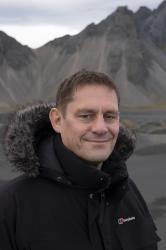Seven days before Christmas, Reykjavík musician Hekla Magnúsdóttir will team up with multimedia artist Lilja María Ásmundsdóttir to perform a groundbreaking concert.
You may know Hekla as one of Iceland’s foremost practitioners of the theremin, the otherworldly-sounding electronic instrument invented in the 1920s by a Russian physicist. And Lilja María can list among her creative achievements the design and construction of a unique stringed instrument—the hulda—that produces both sound and light, and which she will play at the concert.
Hekla and Lilja María studied composition together at the Iceland Academy Of Arts, and they’re staging the concert at Hannesarholt to unveil their new joint creation, entitled ‘Lofthjúpur’. “It’s like the edge of the world, where space starts, you know?” Helka says when asked about the meaning of the name, “kind of like where oxygen stops.”

Lilja María with her hulda – photo by Pola Maria
Denatured sounds
In addition to her hulda, Lilja María will be playing prepared piano; one where the tone of the strings has been deliberately denatured, for example by resting screws on them, or weaving wooden pegs between them. “And the sounds that come out—these two unusual sounds that you don’t hear often—just mix so beautifully with the theremin,” Helka says. “It’s like a very airy atmosphere.”
The duo will also perform some theremin classics which were composed a century or so ago. “It’s some of the earliest written electronic music, like a piece by Schillinger from 1929 and a piece by Wilkens called ‘Dance In The Moon,’” Hekla says, recalling a time when writing conventional music for theremin was routine for many composers.
A quirky curio
These days—at least, compared to a century ago—the theremin is mainly viewed as a quirky curio, tending to serve more experimental types of music. However Hekla’s unconventional approach extends beyond her choice of instrument and, despite being a formally trained musician, she eschews standard musical notation for her theremin compositions. She has instead devised a system all her own: a form of graphical notation which makes sense to her, but could also be learned by other players.
“When you’re playing, you’re kind of drawing in the air,” Hekla explains, referring to the fact that the player doesn’t actually touch a theremin while playing it. “So I find it really helpful while I’m scoring to just make an abstract sketch of what it’s going to sound like.”
Looking at Hekla’s notation, it’s easy to visualise the graceful hand movements of the player that the swoops and squiggles represent. And those swoops and squiggles are quite beautiful on the page, a bonus not lost on their creator who is selling colourful prints of the notation online. “A great Christmas present for a grandfather or aunt who is practicing the theremin!” Hekla notes on her Facebook page.

Hekla’s Theremin Notation – image by Hekla
Where space starts and oxygen stops
Hekla and Lilja María intend to record ‘Lofthjúpur’ at some point, and release an extract from it on seven-inch vinyl. To accompany that, they also plan to print the score for the composition, each musician using their own unique personal notation, and include that with the record.
So hop on the sleigh to lofthjúpur; the curved edge of the atmosphere where Earth’s air gently crossfades with space. And have yourself a thereminy Christmas.
The concert takes place at Hannesarholt in Reykjavík on December 18th. Tickets are available from tix.is.

Hekla – photo by Pola Maria
Buy subscriptions, t-shirts and more from our shop right here!
















